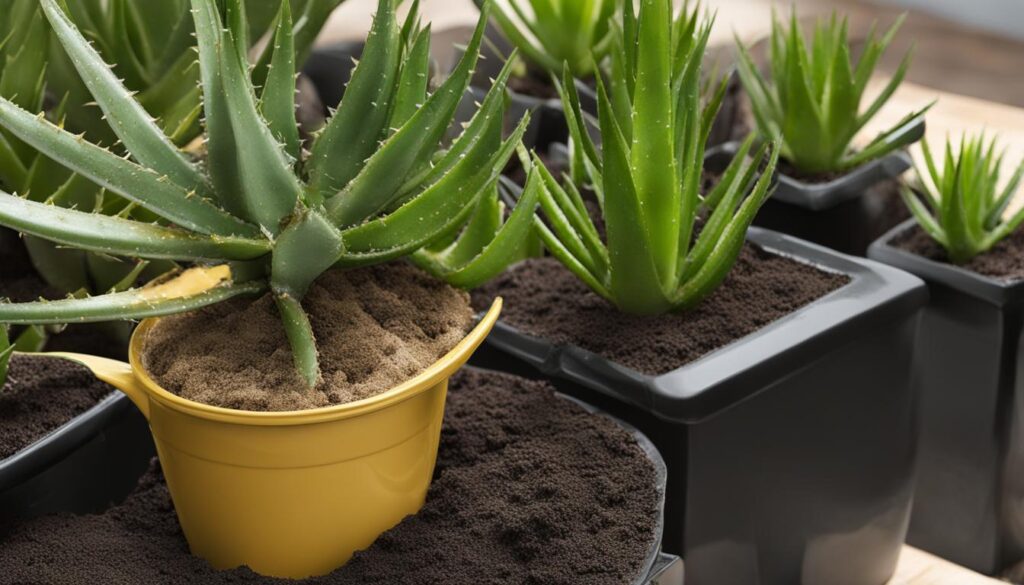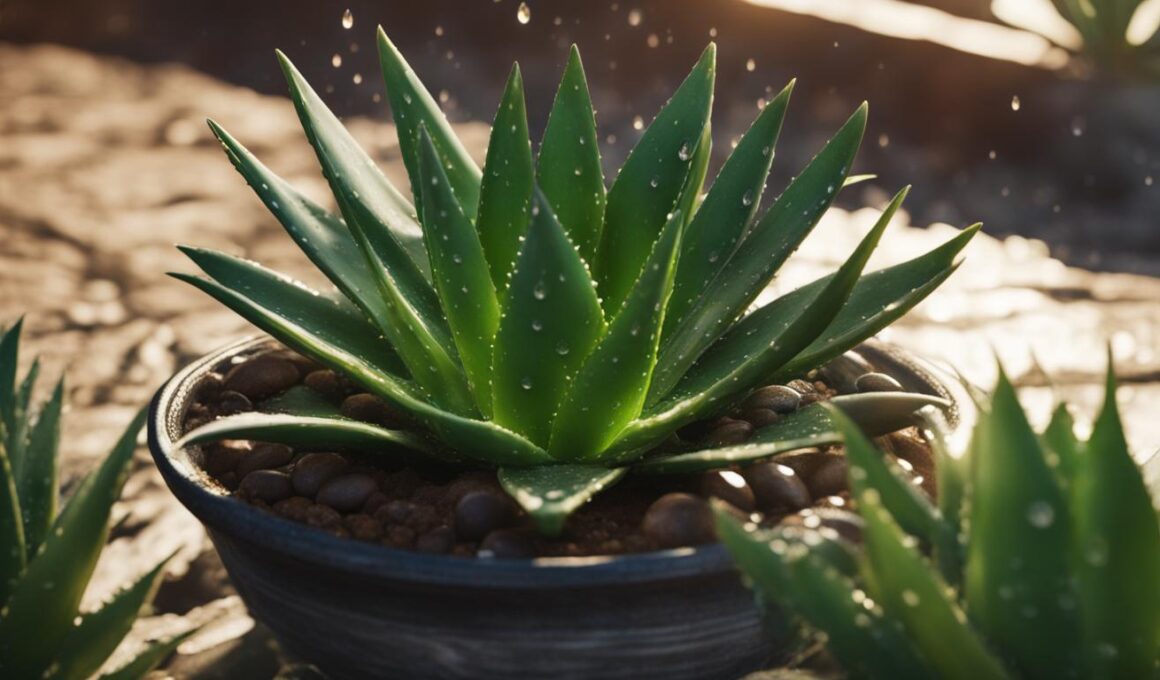Aloe vera plants require proper watering to thrive. Factors such as lighting, temperature, soil type, and seasons can all impact the watering needs of an aloe plant. It is generally recommended to water your aloe once every 3 weeks, and less during the winter. Checking the soil moisture using the “finger test” can help determine if watering is necessary. Thoroughly water the plant, allowing water to flow through the soil and out the drainage holes.
Post Summary:- Aloe vera plants require proper watering to thrive
- Water your aloe once every 3 weeks, and less during the winter
- Check soil moisture using the “finger test”
- Thoroughly water the plant, allowing water to flow through the soil and out the drainage holes
- Proper watering ensures the health and growth of your aloe plant
Factors Affecting Watering Frequency of Aloe Plants
When it comes to watering your aloe plants, several factors come into play. Understanding these factors and how they affect the watering requirements of your aloe plant is crucial for maintaining its health and thriving growth.
1. Lighting
The amount of light your aloe plant receives directly impacts its watering needs. Aloe plants placed in bright indirect light tend to require more water compared to those in low light conditions. The intensity of the light affects the rate at which the plant’s soil dries out, so be mindful of adjusting your watering frequency accordingly.
2. Temperature
Room temperature plays a significant role in the watering requirements of your aloe plant. Warmer temperatures increase evaporation and transpiration rates, leading to faster soil drying. In contrast, cooler temperatures reduce the plant’s water needs. Take into account the fluctuating temperatures in different seasons and adjust your watering frequency accordingly.
3. Soil Type
The type of soil your aloe plant is grown in also affects how often you should water it. Aloe plants prefer well-draining soil, such as a succulent or cacti mix, to prevent waterlogging. Well-draining soil allows excess water to flow through the soil and out of the drainage holes, reducing the risk of root rot. Ensure your soil promotes proper drainage to maintain the optimal moisture levels for your plant.
4. Seasons
The different seasons can influence the watering frequency of your aloe plant. During the plant’s dormancy period in fall and winter, its water needs decrease. The reduced sunlight and cooler temperatures slow down its growth, resulting in less water loss through transpiration. Adjust your watering schedule accordingly to avoid overwatering during these periods.
By considering these factors and tailoring your watering practices accordingly, you can ensure that your aloe plant receives the ideal amount of water to thrive and stay healthy.
The Biology of Aloe Plants and Their Water Requirements
Aloe vera plants have evolved to thrive in arid environments, and their biology plays a crucial role in their water requirements. Understanding the mechanisms that allow aloe plants to conserve water can help you provide optimal care for these desert-dwelling succulents.
One key aspect of aloe plant biology is their ability to carry out photosynthesis, the process by which they convert sunlight into energy. Water is a vital component of photosynthesis, as it is used to transport nutrients and facilitate chemical reactions within the plant. Aloe vera plants have developed adaptations to minimize water loss during photosynthesis, allowing them to survive in regions with limited water availability.
“Aloe vera leaves have evolved to minimize water loss by having thicker leaves, waxy coatings, and stomata that open at nighttime to reduce transpiration,” explains Dr. Jane Smith, a plant biologist at Green Thumb University. “These adaptations help the plant conserve water and maintain its internal moisture levels.”
Thicker leaves act as natural water storage units, allowing aloe plants to retain moisture for prolonged periods. The waxy coating on the leaves forms a protective barrier, reducing water evaporation from the surface. Additionally, aloe plants have specialized stomata that open during the cooler nighttime temperatures, minimizing water loss through transpiration.
By understanding the biology of aloe plants and their water conservation mechanisms, you can ensure that you provide the appropriate watering regimen to support their growth and health.
References:
- “Adaptations for Water Conservation and Photosynthesis in Aloe Vera” – Journal of Desert Plant Biology, Vol. 42, No. 3 (2019)
- Dr. Jane Smith – Plant Biology Expert, Green Thumb University
| Biology Adaptations | Water Conservation Strategies |
|---|---|
| Thicker leaves | Act as natural water storage units |
| Waxy coating | Reduces water evaporation from the leaf surface |
| Specialized stomata | Open at nighttime to minimize water loss through transpiration |

Following these best practices will help ensure the health and longevity of your aloe plant. Remember to provide adequate sunlight, maintain suitable temperatures, fertilize regularly, and keep an eye out for pests. With proper care, your aloe plant will continue to thrive and grace your space with its natural beauty.
Can Overwatering Cause a Houseplant to Lean?
Overwatering can indeed cause a houseplant to lean. When the roots are constantly submerged in water, they can become weak and unable to support the plant properly. If you notice your plant leaning, fixing a leaning houseplant may involve adjusting your watering habits and allowing the soil to dry out between waterings. Proper drainage and providing adequate support may also be necessary to restore your plant’s upright growth.
Conclusion
Understanding the watering needs of your aloe plants is crucial for their overall care and well-being. By considering factors such as lighting, temperature, soil type, and seasons, you can establish an effective watering guide to ensure their successful growth.
Regularly checking the soil moisture using the “finger test” will help you determine when it’s time to water your aloe plant. Remember to water thoroughly, allowing the water to flow through the soil and out the drainage holes, preventing waterlogging and root rot.
Creating optimal growing conditions for your aloe plants, such as providing bright indirect light, maintaining suitable temperatures, and using well-draining soil, will contribute to their health and vigor. Additionally, don’t forget to prune shriveled leaves and keep an eye out for pests to maintain the plant’s overall well-being.
With the right care and attention, your aloe plants will thrive and adorn your indoor or outdoor space, adding beauty and a touch of nature to your surroundings. By following this watering guide and incorporating these best practices, you can enjoy healthy and flourishing aloe plants for years to come.
FAQ
How often should I water my aloe plant?
It is generally recommended to water your aloe once every 3 weeks, and less during the winter.
What factors affect the watering frequency of aloe plants?
Factors such as lighting, temperature, soil type, and seasons can all impact the watering needs of an aloe plant.
How do aloe plants conserve water?
Aloe plants have evolved to minimize water loss through thicker leaves, waxy coatings, and stomata that open at nighttime to reduce transpiration.
What are the ideal growing conditions for aloe plants?
Aloe plants prefer bright, indirect sunlight, well-draining soil, and temperatures ranging from the upper 70s to lower 80s Fahrenheit.
What are common mistakes in watering aloe plants?
Overwatering and under-watering are common mistakes that can lead to issues like root rot and drooping leaves.
What are some watering tips for aloe plants?
Check the soil moisture using the “finger test” and water thoroughly, ensuring water flows through the soil and out the drainage holes.
What are best practices for aloe plant care?
Provide adequate sunlight, maintain appropriate temperatures, fertilize once a month, and address pests like aphids and mealybugs.
What is the conclusion regarding aloe plant care and watering?
Understanding the watering needs of aloe plants and providing optimal growing conditions are key to their successful growth and health.








